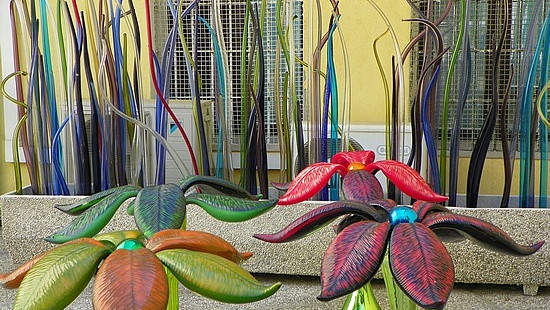
Venice is just one “island community” (actually it’s an amalgamation of 100 smaller islands) in the shallow brackish waters of the Laguna Veneta. There are several other island communities in this large (>200 square mile) lagoon that can be comfortably visited in an enjoyable day trip from Venice all easily accessible by vaporetto. Settlers fled to these islands when the barbarians invaded Italy over 1500 years ago because the islands were safe from these marauders and sheltered from the strong winds and waves of the Adriatic Sea.

Murano Fire Watch Tower
1) MURANO
Murano is best known for its glass factories and the wondrous assortment of beautiful glass products they generate. The island itself was initially developed in the 13th century because of the danger of fire from the hot furnaces required to smelt glass; to protect Venice, glass production was restricted to Murano. Hundreds of years later glass production is still synonymous with the island and you can watch glass being blown in many small factories around the town (they offer a short “free tour” followed by a heavy sales pitch). These products are also available in dozens of shops in Murano and Venice and include jewelery, plates, glasses, vases, wine decanters — the assortment is astounding and the color and quality of the glass is truly wonderful!
The island features a small Glass Museum, the highlight of which was a nice collection of ancient Roman era glass and antique equipment used to throw glass. The museum also features exhibits of the best of Venetian glass making; you can also see many great glass art sculptings throughout the city so if your time is limited this is a museum you could skip. Just north of the Glass Museum is the dominant church on the island, Santa Maria e San Donato Church, a 12th century church featuring beautiful inlaid floors and mosaics.
Murano is much less heavily touristed than Venice and features large residential areas where people actually live and children play (unlike most of Venice which is dominated by tourists and the industries that support them). I found this aspect of Murano as appealing as the glass production on the island.

Burano, canals
2) BURANO
Burano is a small island community of a few thousand people, historically a sleepy fishing village, best known for its lovely lace and the colorful pastel houses that line its canals. Its church tower is a dominant landmark and, like the leaning tower of Pisa, demonstrates a 5 degree tilt. While Burano is popular with tourists during the day, at night the town shuts down, with the exception of a few restaurants. For those who would like to “get away”, a few nights might be just the ticket.

Vineyard in Torcello
3) TORCELLO
Over a millenia ago, this was the first island that developed in the lagoon, and while mostly deserted and overgrown by shrubs, this island is home to Santa Maria Assunta church, the oldest church in the lagoon. A church on this site dates to the 7th century, although little remains of the original structure. There is a vaporetto that runs regularly between Burano and Torcello, a fairly quick ride, followed by a walk along a canal towards the church complex (comprised of the church, bell tower, sacristy and small museum). The church is memorable for its old mosaics and it’s a nice one hour excursion. The bell-tower offers great views of the surrounding lagoon, although it was closed for refurbishing when we visited.
(Click on thumbnails to enlarge, right arrow to advance slideshow)












































